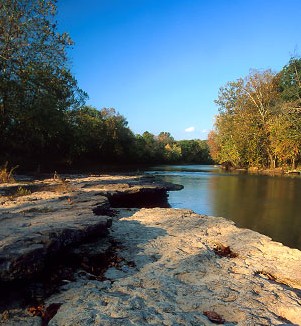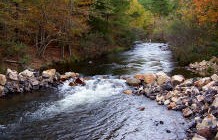Oklahoma's Illinois
River
Information provided by Brock of Oklahoma Fly Fishing
The scenic Illinois River is located
near Tahlequah Oklahoma meandering through the Cookson Hills of
Eastern Oklahoma. The river is well known and primarily thought of
as a canoeing river. The stream head waters begin in Arkansas and
flow through low mountains, hills and valleys for 68 miles before
entering Tenkiller Lake. The useable portion of the river is
generally accepted as beginning at the Lake Frances Dam near Watts
Oklahoma.

The Illinois River is a wild and scenic stream left in its
natural state for the enjoyment of recreationalists and wildlife
enthusiasts alike. During the summer months the stream is heavily
traveled by canoeist. It is generally a class II river during normal
flow conditions.
The stream water is noted to be clear to near clear with a gravel
and rock stream bed. Some silting occurs in back water eddies at the
streams deeper holes. Rock and boulders are sporadically scattered
along the length of the stream. In the upper 1/2 to 1/3 portion of
the river, steep bluffs, ledges and a bed rock stream bed is common.
The stream has numerous trees that have washed in or fallen in the
stream in several areas. The roots and trunks of these trees create
excellent fish cover as well as a moderate hazard for canoeist. The
stream has many gravel bars throughout it's length with short to
moderately long holes of varying depth between shallows.
The stream is best fished from canoe or flat bottom John boat.
Wade fishing at several access points is possible. However, the
amount of water that can be covered at these access points is often
limited due to deep water up and downstream from these areas. Most
public access points will accommodate a hundred yards or more up and
downstream for wade fishing. However, during the summer months most
of these areas are usually populated by swimmers, sunbathers,
beaching canoes and float outfitters delivering their customers to
the stream.
Floating the river and beaching at likely spots along the rivers
length provides greater access to productive water and far more
enjoyment of the river, and your fly fishing trip.
The "Canoe Hatch" can be a problem for the fly fisher during the
summer months. On a typical hot, summer day, hundreds of canoeist
and rafters will be on the river. The weekends are very crowded at
times. The best time to fish the river is during the weekdays and
early morning and late evening hours. If using one of the commercial
canoe outfitters along the river, the upper portion of the river
(upstream of Chewey Bridge to Round Hollow) receives less canoe
traffic than the middle and lower portion of the river. Riverside
Floats, one of the last upstream commercial Outfitters,
traditionally runs this section of the river when water levels
permit. A fourteen mile and seven mile float is available with
put-ins upstream of Chewey Bridge or at the bridge for the seven
mile trip. The take out point is at the Round Hollow Public Access.
To get completely away from summertime canoe traffic, you must
travel further upstream. The community of Watts near the Arkansas -
Oklahoma State line has one or two canoe outfitters located in the
area. This far upper stretch is floatable without much trouble
except during the very low water flows in the heat of the summer.
This upper stretch is lightly fished with many areas probably not
fished at all.
The length of the river (68 miles) makes it idea for multi-day
floating and overnight camping. However, if one chooses to camp on
the river, be very aware of the weather at all times. Even moderate
rains upstream can cause the river to rise several feet very
quickly.
There are over 70 species of fish in the river. Smallmouth Bass,
Black Bass, Channel Catfish, Sunfish and larger Perch are the
predominate "catchable" species. During the early spring of the
year, Sandbass migrate up into the lower portion of the river from
Tenkiller Lake on spawning runs.
Primary food sources for the fish include crawdads, minnows,
hellgrammites, sculpins and Madtoms (black catfish). These Black
catfish are small (one to three inches in length), coal black,
miniature catfish that burrow into the gravel in the shallows.
Smallmouth and Black Bass go "crazy" over these delicacies and a
large black weighted woolly bugger or other imitation can be very
productive.
There are nine major public access points along the length of the
river with several other points accessible by riverside canoe
outfitters. Access is also possible at low water bridge crossings in
the upper portion of the river. The following major access points,
not including riverside canoe outfitters, are listed by river miles
downstream from the Lake Frances Dam near Watts Oklahoma.


